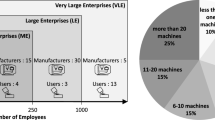Abstract
Modern machine tools are highly optimized with respect to their design and the production processes they are capable to. Now for further advances, especially a detailed knowledge about the thermo-elastic behavior is needed, because the nowadays still existing deficits are mainly related to this. That is why, endeavors in improvement, like the optimization of the design, the evaluation of new materials and the regulation of the production process, particularly rely on accurate computed thermal deformations. One possible approach to increase their quality is to also include the relevant structural variabilities of the machine tools as well as the resulting interactions between the coupled parts within the calculations. In this article, three different numerical methods are presented, which include structural motions in thermo-elastic analyses. Thereby, several conflicting criteria, like real-time capability, memory saving issues and accuracy are fulfilled each time in a different manner. Those methods are afterwards compared with respect to their runtime and accuracy. Finally, the paper concludes with a classification of the usability of the methods in real-time control and optimization tasks.






Similar content being viewed by others
Notes
Collaborative Research Center/Transregio 96—“Thermo-Energetic Design of Machine Tools,” http://transregio96.de.
AMDiS - Adaptive Multi-Dimensional Simulations, www.amdis-fem.org/.
References
Antoulas AC (2005) Approximation of large-scale dynamical systems. SIAM Publications, Philadelphia
Baur U, Beattie CA, Benner P, Gugercin S (2011) Interpolatory projection methods for parameterized model reduction. SIAM J Sci Comput 33(5):2489–2518
Calvo M, Chartier P, Murua A, Sanz-Serna J (2011) Numerical stroboscopic averaging for odes and daes. Appl Numer Math 61(10):1077–1095. doi:10.1016/j.apnum.2011.06.007
Weinan E, Engquist B (2003) The heterognous multiscale methods. Commun Math Sci 1(1):87–132
Freitas F, Rommes J, Martins N (2008) Gramian-based reduction method applied to large sparse power system descriptor models. IEEE Trans Power Syst 23(3):1258–1270
Großmann K, Städel C, Galant A, Mühl A (2012) Werkzeugmaschinen-Berechnung von Temperaturfeldern an Werkzeugmaschinen. Zeitschrift fur Wirtschaftlichen Fabrikbetrieb 107(6):452–456
Gerisch A, Naumann A, Wensch J (2015) Defect corrected averaging for highly oscillatory problems. Appl Math Comput 261(0):90–103
Gugercin S, Antoulas AC, Beattie C (2008) \({\cal H}_2\) model reduction for large-scale dynamical systems. SIAM J Matrix Anal Appl 30(2):609–638
Haasdonk B, Ohlberger M (2009) Efficient reduced models for parametrized dynamical systems by offline/online decomposition. In: Proceedings of MATHMOD 2009, 6th Vienna international conference on mathematical modelling
Hüeber S, Wohlmuth B (2009) Thermo-mechanical contact problems on non-matching meshes. Comput Methods Appl Mech Eng 198:1338–1350
Jungnickel G (2010) Simulation des thermischen Verhaltens von Werkzeugmaschinen/Modellierung und Parametrierung. Inst. für Werkzeugmaschinen und Steuerungstechnik, Lehrstuhl für Werkzeugmaschinen, Inst. für Werkzeugmaschinen und Steuerungstechnik, Lehrstuhl für Werkzeugmaschinen, Dresden
Lang N, Saak J, Benner P (2014) Model order reduction for systems with moving loads. at-Automatisierungstechnik 62(7):512–522
Nestmann S (2006) Mittel und Methoden zur Verbesserung des thermischen Verhaltens von Werkzeugmaschinen. In: Reinhart G, Zäh M (eds) IWB Seminarberichte, vol 83. Herbert Utz Verlag
Partzsch M, Beitelschmidt M (2015) Simulation of pose- and process-dependent machine tool models. In: Großmann K (ed) Thermo-energetic design of machine tools, chap. 6, pp 61–68. Springer International Publishing, Switzerland. doi:10.1007/978-3-319-12625-8_6
Saad Y, Schultz MH (1986) Gmres: a generalized minimal residual algorithm for solving nonsymmetric linear systems. SIAM J Sci Stat Comput 7(3):856–869
Strehmel K, Weiner R, Podhaisky H (2012) Numerik gewöhnlicher Differentialgleichungen/nichtsteife, steife und differential-algebraische Gleichungen, 2., überarb. und erw. aufl. edn. Springer Spektrum, Springer Spektrum
Verwer J, Spee E, Blom J, Hundsdorfer W (1999) A second-order Rosenbrock method applied to photochemical dispersion problems. SIAM J Sci Comput 20(4):1456–1480. doi:10.1137/S1064827597326651
Witkowski T, Ling S, Praetorius S, Voigt A (2015) Software concepts and numerical algorithms for a scalable adaptive parallel finite element method. Advances in computational mathematics, pp 1–33. doi:10.1007/s10444-015-9405-4
Acknowledgments
The authors thank the German Research Foundation for funding this work within the CRC/TR 96 and ZIH for the provided computing resources. We further thank Alexander Galant for providing the example used here.
Author information
Authors and Affiliations
Corresponding author
Rights and permissions
About this article
Cite this article
Naumann, A., Lang, N., Partzsch, M. et al. Computation of thermo-elastic deformations on machine tools a study of numerical methods. Prod. Eng. Res. Devel. 10, 253–263 (2016). https://doi.org/10.1007/s11740-016-0674-7
Received:
Accepted:
Published:
Issue Date:
DOI: https://doi.org/10.1007/s11740-016-0674-7



